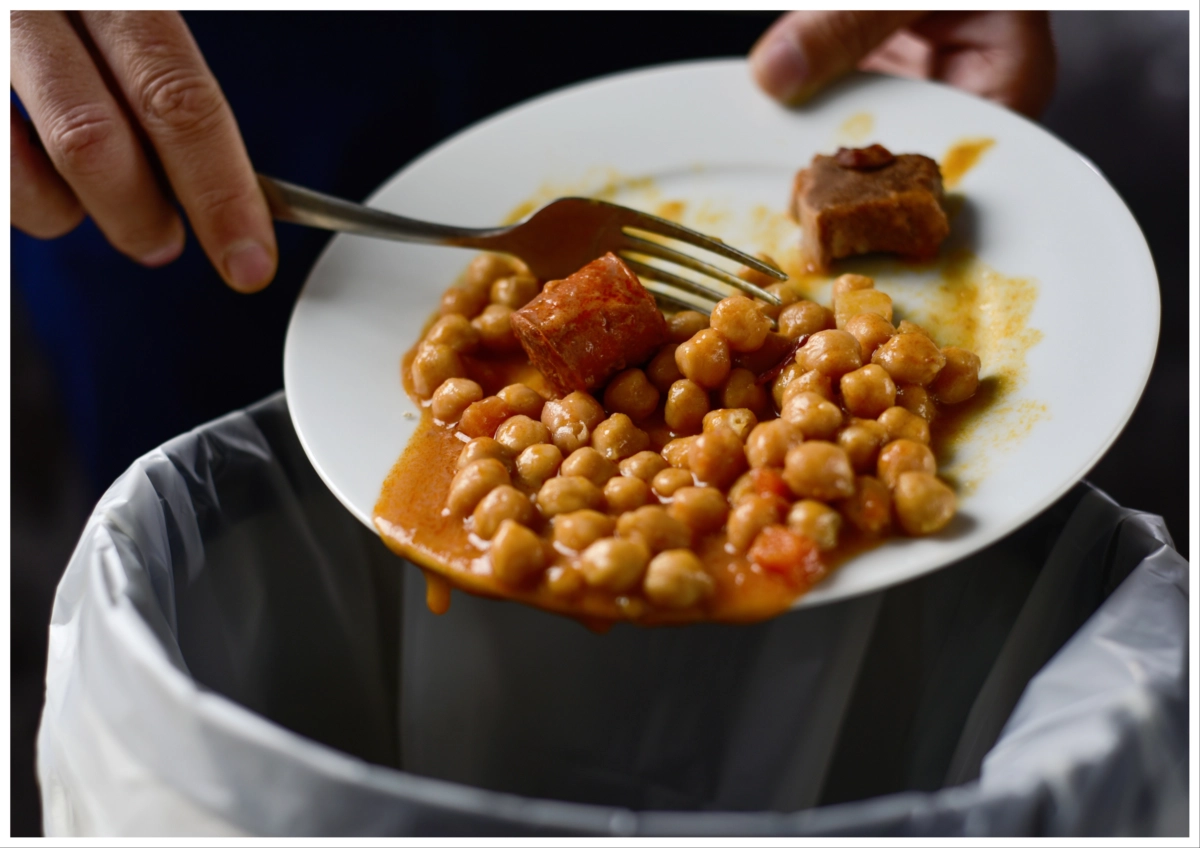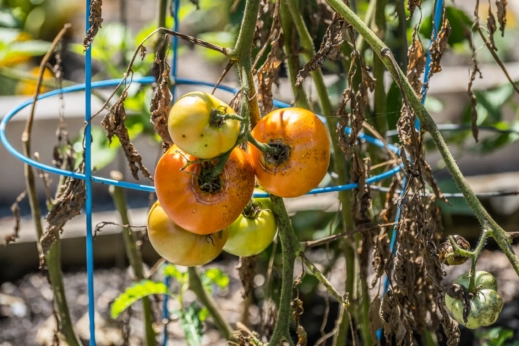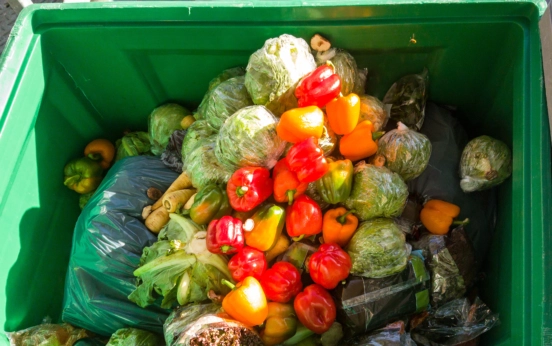The Staggering Scale of Food Waste, Explained
The US wastes a third of its food. Here’s where it happens and how.
The Staggering Scale of Food Waste, Explained
The US wastes a third of its food. Here’s where it happens and how.

Nearly half of food waste happens at home.by Shutterstock
Most people don’t set out to waste food. And yet, we’re pretty much all guilty of it.
It happens everywhere in our food system. Tomatoes that don’t meet product specifications get left on the vine at farms. Byproducts of processed foods get tossed out on the manufacturing line. Ugly lemons get picked over at the supermarket. At home, we throw out the wilting spinach in our refrigerator that we bought when we had grand plans to cook, then ended up ordering takeout instead.
All of these things add up; food waste cost the US $428 billion in 2022. In addition to the monetary costs, wasted food could be going to those who need it—12.8 percent of American households were food insecure in 2022. Environmentally that same year, the US expended 6.1 percent of its greenhouse gas emissions on food that never gets eaten, as well as an estimated 16 percent of US cropland and 22 percent of its freshwater use.
The thing is, reducing wasted food is completely possible. A close look at where it happens in the food system, and how, reveals how interventions can make a difference in achieving our food waste goals.
Big goals for 2030
In 2015, the United Nations created a Sustainable Development Goal, or SDG, to halve food waste at the consumer and retail levels by 2030. The US joined in pursuit of this goal, thereby taking on the biggest food waste challenge in the world.
Now, in 2024, we have passed the halfway point to that deadline, but food waste is still a monumental problem in the US.
However, there have been some interesting fluctuations in this trend. The onset of the COVID-19 pandemic and subsequent lockdown exposed weaknesses in our food system, but it also dramatically changed people’s eating habits, as well as their waste habits. Research indicates that the onset of the pandemic resulted in reductions in household food waste in many countries at first … “and then kind of a return to normal levels of waste thereafter,” says Brian Roe, leader of the Ohio State Food Waste Collaborative.
We don’t have definitive data as to why, but Roe offers a guess: In general, people were home more, going to the grocery store less frequently and not eating out at restaurants as much. As things began to re-open, food waste levels went back to “normal.”
Another interesting part of the food waste discussion at the national level is that municipal composting programs are becoming more common. However, compost doesn’t count toward the SDG food waste reduction goals. These measures will have to be achieved through upstream interventions. So, where in the food system can this happen?
On the farm: 16.8 percent of surplus food
When it comes to fruits and vegetables, Dana Gunders, executive director of ReFED, says occasional overproduction can be attributed to fluctuating markets. Because of that, growers are always playing a guessing game about how much they will be able to sell and the price they will fetch versus the basic cost of harvest.
There’s also the question of aesthetics. “You also have products that are systematically left in the field because of their specs. They’re not meeting specs, for one reason or another. It could be size, shape, color, sweetness, but it also could be that they have two weeks of shelf life left instead of three.”
Labor or budget shortages can also result in food left on the vine—perhaps farms only find it possible to pay workers to go out in the field twice instead of three times and food gets left behind. Gleaning programs can address this.
But produce isn’t the only food that can be wasted on farms. Gunders says produce gets a lot of the focus, but that there are also wasted eggs, meat, dairy and commodity grains.

In processing: 14.7 percent of surplus food
Manufacturing is decently efficient, says Gunders. But the byproducts of certain items can be a source of wasted food in the system. For example, if you’re making french fries, you may be tossing your potato peels, even though they are edible.
The upcycled food movement has stepped in to try to figure out how to address some of these issues.
At grocery stores and restaurants: 20.2 percent of surplus food
A typical grocery store sells tens of thousands of different items, a fair few of which are not shelf-stable. Grocery stores must estimate how much of something they think they will sell, and they won’t always get it right. US grocery stores produce five million tons of food waste annually.
Seventy percent of the food wasted at restaurants happens in the front of the house, not in the kitchen. Often, this happens through big portions. Patrons can’t finish the food and it gets left on the plate.
A handful of states have passed legislation addressing surplus food at this level, either through organic waste bans, providing tax incentives to donate surplus food or liability protections for donated food, such as that which has passed its “best by” date. You can find more about what each state is up to using ReFED’s Policy Finder.

At home: 48.2 percent of surplus food
The biggest share of food waste occurs at home. This makes the environmental impact even stronger—not only is the food wasted, but so much energy was used to get it from the farm, through the food system and into your kitchen.
“It really boils down to the fact that we’re not very good at managing our food,” says Gunders.
Fortunately, steps for reducing your home footprint are pretty accessible. A recent pilot study out of the University of Guelph found that at-home educational interventions can help reduce food waste. You can access the manual it used at home here. And for actionable tips for what you can do at home, read our how-to here.
“I’m a big believer that we need to chip away at the consumer level because it is the source of the most. And by the time it gets to the consumer, it has embedded increasing amounts of energy and other resources. You’ve transported it a few more times, you’ve refrigerated it for longer, you burned more energy [and] created more emissions to get it to the consumer level,” says Roe.
Prevention vs. reaction
When it comes to food waste solutions, many fall on one end of the spectrum or the other: preventing food from being wasted in the first place versus getting use out of it once it has been wasted. Both sides are valuable.
Preventive strategies help cut down on the amount of money and energy used to create food that doesn’t get eaten.
But disposing of wasted food the right way is also important. Landfills are the third greatest producers of human-driven methane in the US. An EPA study from 2023 found that an estimated 58 percent of the methane produced by landfills was due to food waste. Food, when tossed in the landfill, generates this greenhouse gas. The way to cut down on this is by redirecting food waste away from landfills. Compost, if managed properly through the integration of oxygen, will not create such high levels of methane. Check out our tips on compost best practices here.
“Getting a system in place throughout the country to really systematically get that food out of landfills, is now taking, I would say, more prominence as a good climate strategy,” says Gunders.
Learn more. Most of the data used in this article was sourced from ReFED, a leader in understanding food waste through data. Check out its homepage, Insights Engine and Policy Finder for more information.
Follow us
This work is licensed under a Creative Commons Attribution-NoDerivatives 4.0 International License.
Want to republish a Modern Farmer story?
We are happy for Modern Farmer stories to be shared, and encourage you to republish our articles for your audience. When doing so, we ask that you follow these guidelines:
Please credit us and our writers
For the author byline, please use “Author Name, Modern Farmer.” At the top of our stories, if on the web, please include this text and link: “This story was originally published by Modern Farmer.”
Please make sure to include a link back to either our home page or the article URL.
At the bottom of the story, please include the following text:
“Modern Farmer is a nonprofit initiative dedicated to raising awareness and catalyzing action at the intersection of food, agriculture, and society. Read more at <link>Modern Farmer</link>.”
Use our widget
We’d like to be able to track our stories, so we ask that if you republish our content, you do so using our widget (located on the left hand side of the article). The HTML code has a built-in tracker that tells us the data and domain where the story was published, as well as view counts.
Check the image requirements
It’s your responsibility to confirm you're licensed to republish images in our articles. Some images, such as those from commercial providers, don't allow their images to be republished without permission or payment. Copyright terms are generally listed in the image caption and attribution. You are welcome to omit our images or substitute with your own. Charts and interactive graphics follow the same rules.
Don’t change too much. Or, ask us first.
Articles must be republished in their entirety. It’s okay to change references to time (“today” to “yesterday”) or location (“Iowa City, IA” to “here”). But please keep everything else the same.
If you feel strongly that a more material edit needs to be made, get in touch with us at [email protected]. We’re happy to discuss it with the original author, but we must have prior approval for changes before publication.
Special cases
Extracts. You may run the first few lines or paragraphs of the article and then say: “Read the full article at Modern Farmer” with a link back to the original article.
Quotes. You may quote authors provided you include a link back to the article URL.
Translations. These require writer approval. To inquire about translation of a Modern Farmer article, contact us at [email protected]
Signed consent / copyright release forms. These are not required, provided you are following these guidelines.
Print. Articles can be republished in print under these same rules, with the exception that you do not need to include the links.
Tag us
When sharing the story on social media, please tag us using the following: - Twitter (@ModFarm) - Facebook (@ModernFarmerMedia) - Instagram (@modfarm)
Use our content respectfully
Modern Farmer is a nonprofit and as such we share our content for free and in good faith in order to reach new audiences. Respectfully,
No selling ads against our stories. It’s okay to put our stories on pages with ads.
Don’t republish our material wholesale, or automatically; you need to select stories to be republished individually.
You have no rights to sell, license, syndicate, or otherwise represent yourself as the authorized owner of our material to any third parties. This means that you cannot actively publish or submit our work for syndication to third party platforms or apps like Apple News or Google News. We understand that publishers cannot fully control when certain third parties automatically summarize or crawl content from publishers’ own sites.
Keep in touch
We want to hear from you if you love Modern Farmer content, have a collaboration idea, or anything else to share. As a nonprofit outlet, we work in service of our community and are always open to comments, feedback, and ideas. Contact us at [email protected].by Lena Beck, Modern Farmer
February 22, 2024
Modern Farmer Weekly
Solutions Hub
Innovations, ideas and inspiration. Actionable solutions for a resilient food system.
ExploreShare With Us
We want to hear from Modern Farmer readers who have thoughtful commentary, actionable solutions, or helpful ideas to share.
SubmitNecessary cookies are absolutely essential for the website to function properly. This category only includes cookies that ensures basic functionalities and security features of the website. These cookies do not store any personal information.
Any cookies that may not be particularly necessary for the website to function and are used specifically to collect user personal data via analytics, ads, other embedded contents are termed as non-necessary cookies.
I think people should use there scraps for there garden
Oh, hopefully food waste will soon be treated cleanly without leaving any consequences for the environment.
So what was wrong with my comment?